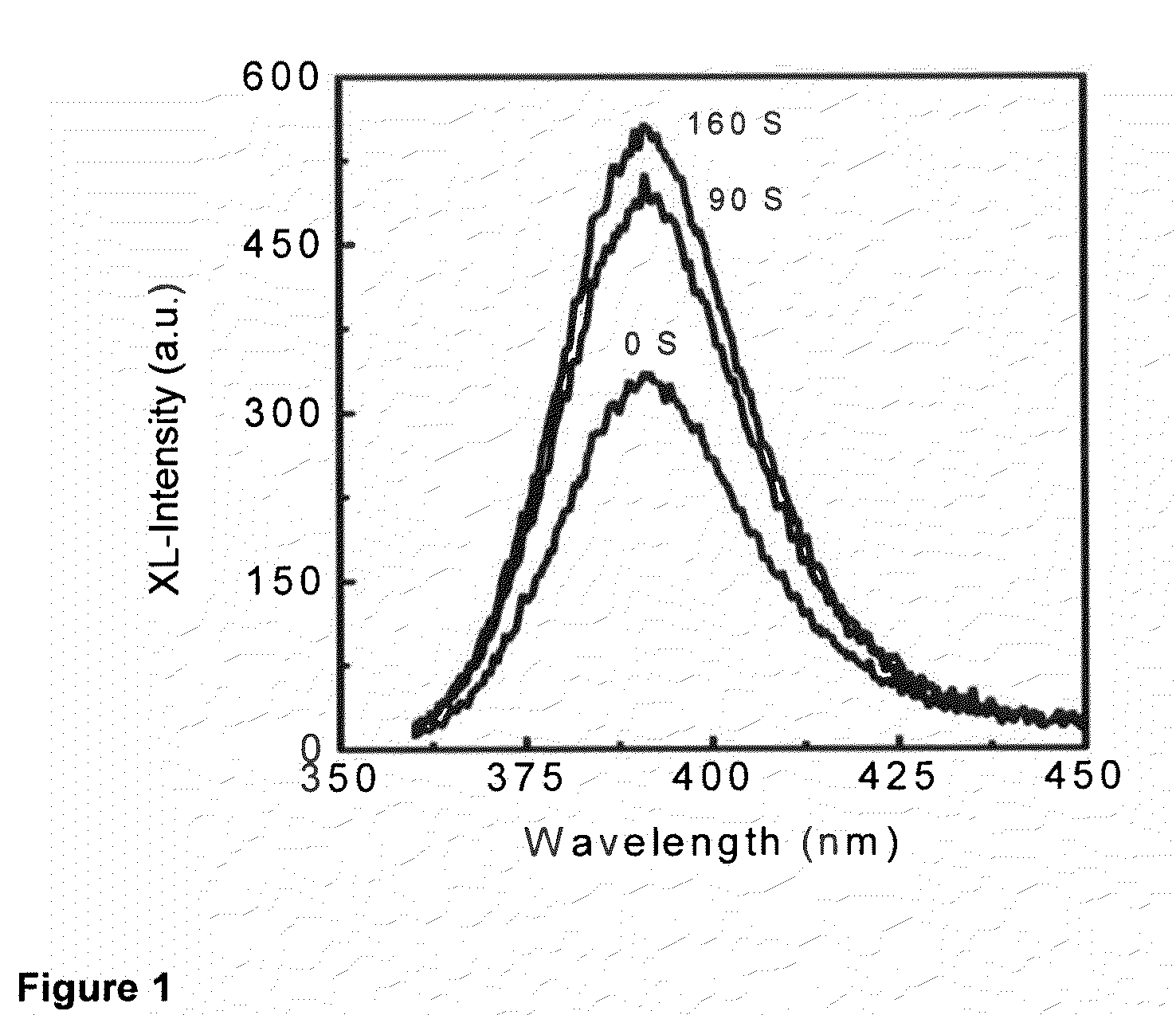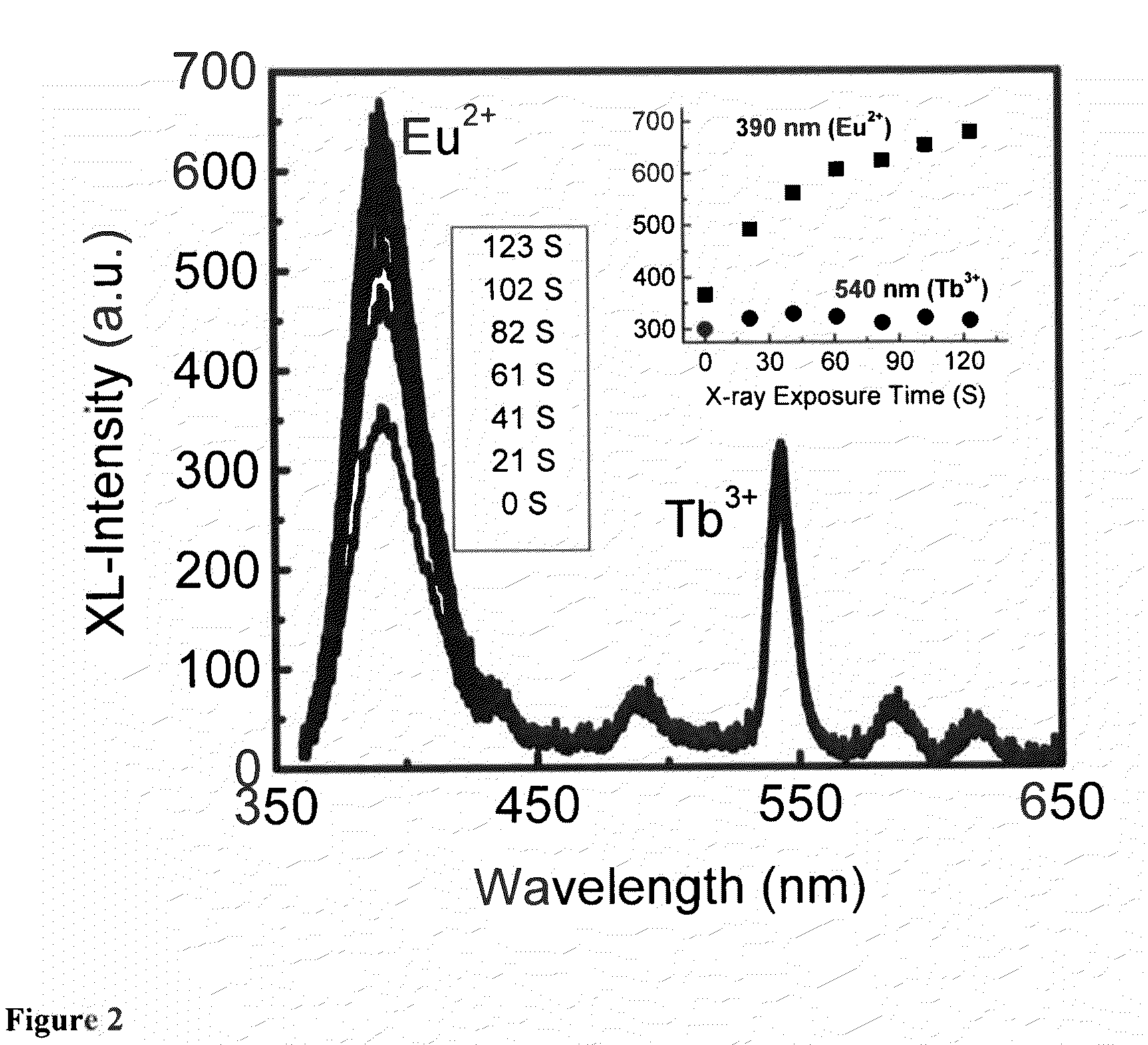Energy-transfer nanocomposite materials and methods of making and using same
a technology of energy-transfer nanocomposite materials and nano-composite materials, which is applied in the field of radiation dosimetry and imaging, can solve the problems of low stopping power of most semiconductors, weak scintillation luminescence, and inability to provide the desired combination of stopping power
- Summary
- Abstract
- Description
- Claims
- Application Information
AI Technical Summary
Benefits of technology
Problems solved by technology
Method used
Image
Examples
example 1
Preparation of CdSe Nanoparticles
[0106]One recipe for the synthesis of CdSe nanocrystals is given here as an example. A similar recipe is used for PbSe. Citrate-stabilized CdSe nanocrystals are prepared according to the following procedure: To 45 ml of water were added 0.05 g sodium citrate (Fluka) and 2 ml of 4×10−2 M cadmium perchlorate (Aldrich). The pH was adjusted to 9.0 by 0.1 M NaOH (Alfa). The solution was bubbled with nitrogen for 10 minutes, and then 2 ml of 1×10−2 M N,N-dimethylselenourea (Alfa) was added. The mixture was heated in a conventional 900-watt microwave oven for 50 seconds. In this recipe, the Cd:Se molar ratio is 4:1, which leads to CdSe nanoparticles with ˜4.0 nm diameter; by increasing the Cd concentration it is possible to synthesize smaller CdSe nanoparticles.
example 2
Preparation of CdSe / CdS Core / Shell Nanoparticles
[0107]For the preparation of core-shell CdSe / CdS nanoparticles, the CdSe aqueous solution synthesized above was used as the initial material with thioacetamide as the sulfur source. To a given amount of the CdSe solution was added a 4×10−2 M solution of thioacetamide (Alfa) in a quantity such that the molar ratio of Sadded:Seinitial was 1:1. For example, to 10 mL of the 4×10−4 M (in Se) CdSe solution from Example 1, 0.1 mL of 4×10−2 M solution of thioacetamide was added to have a molar ratio of Sadded:Seinitial of 1:1. The mixture was heated in a round-bottom flask under Ar flow at 70-80° C. for 24 hours. Then the solution was placed in ambient temperature to enhance its luminescence.
[0108]Citrate-stabilized CdSe nanoparticles made in this way show well-defined 1s-1s electronic transitions in their absorption spectra. The room-temperature excitonic emission of CdSe nanoparticles is weak. In the course of the preparation of core / shell n...
example 3
Preparation of CdTe:Mn2+Nanoparticles
[0109]Doped CdTe:Mn2+ nanoparticles were prepared by a wet chemical technique which has been reported widely. Cadmium perchlorate hydrate (Aldrich), aluminum telluride (99.5% pure, Cerac), and thioglycolic (mercaptoacetic) acid (Aldrich) were used as received. CdTe nanoparticles were prepared by the rapid mixing of precursors containing cadmium perchlorate hydrate and sodium hydrotelluride (NaHTe), cooled to 5° C., under vigorous stirring. The Cd2+ containing solution was prepared as follows: 0.70 g of Cd(ClO4)2*H2O and 0.05 g Mn(ClO4)2*H2O were dissolved in 125 mL of water. 0.3 mL of thioglycolic acid (TGA) was added to the solution and its pH was adjusted to ˜11.2 by the addition of 0.1M NaOH. The solution was then purged with nitrogen for at least 30 minutes. The solution of NaHTe was prepared in a vessel cooled with water ice to 5° C. by bubbling an excess of H2Te through 22 mL of 0.05M NaOH for 40 minutes under nitrogen. The hydrogen telluri...
PUM
| Property | Measurement | Unit |
|---|---|---|
| wavelengths | aaaaa | aaaaa |
| emission wavelengths | aaaaa | aaaaa |
| sizes | aaaaa | aaaaa |
Abstract
Description
Claims
Application Information
 Login to View More
Login to View More - R&D
- Intellectual Property
- Life Sciences
- Materials
- Tech Scout
- Unparalleled Data Quality
- Higher Quality Content
- 60% Fewer Hallucinations
Browse by: Latest US Patents, China's latest patents, Technical Efficacy Thesaurus, Application Domain, Technology Topic, Popular Technical Reports.
© 2025 PatSnap. All rights reserved.Legal|Privacy policy|Modern Slavery Act Transparency Statement|Sitemap|About US| Contact US: help@patsnap.com



